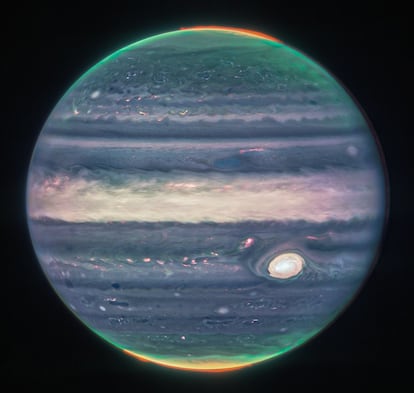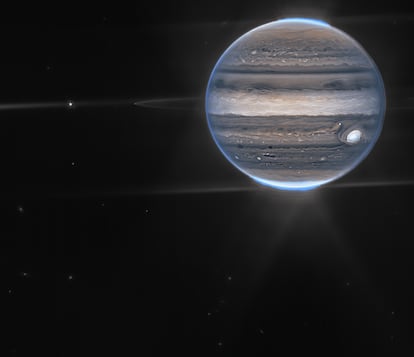James Webb space telescope captures Jupiter’s auroras, rings and satellites
The photos also feature the Great Red Spot, a famous storm so big it could swallow Earth

The James Webb space telescope, a joint mission of NASA, European Space Agency (ESA) and the Canadian Space Agency (CSA), has released new images of Jupiter, which is the largest planet in the Solar System. The photos taken by the James Webb, the largest space observatory ever launched into space, has revealed details of Jupiter’s auroras, rings and satellites.
The two images released by NASA were taken with a Near-Infrared Camera (NIRCam), which has three specialized filters to capture infrared radiation, which is invisible to the human eye. In the standalone view of Jupiter, created from a composite of several images from the James Webb, auroras extend to high altitudes above both the northern and southern poles of Jupiter, NASA explained. The images also highlight light reflected from lower clouds and upper hazes.
The photos also feature the Great Red Spot, a famous storm so big it could swallow Earth. “The numerous bright white ‘spots’ and ‘streaks’ are likely very high-altitude cloud tops of condensed convective storms,” said Heidi Hammel, an interdisciplinary scientist on the space telescope mission, in a NASA statement. By contrast, dark ribbons north of the equatorial region have little cloud cover, the statement explained.

The wide-field view of Jupiter shows its rings and two moons called Amalthea and Adrasthea. The fuzzy spots in the lower background are likely galaxies. Researchers have already begun analyzing Webb’s data on the largest planet in the Solar System and the fifth furthest from the Sun.
Tu suscripción se está usando en otro dispositivo
¿Quieres añadir otro usuario a tu suscripción?
Si continúas leyendo en este dispositivo, no se podrá leer en el otro.
FlechaTu suscripción se está usando en otro dispositivo y solo puedes acceder a EL PAÍS desde un dispositivo a la vez.
Si quieres compartir tu cuenta, cambia tu suscripción a la modalidad Premium, así podrás añadir otro usuario. Cada uno accederá con su propia cuenta de email, lo que os permitirá personalizar vuestra experiencia en EL PAÍS.
¿Tienes una suscripción de empresa? Accede aquí para contratar más cuentas.
En el caso de no saber quién está usando tu cuenta, te recomendamos cambiar tu contraseña aquí.
Si decides continuar compartiendo tu cuenta, este mensaje se mostrará en tu dispositivo y en el de la otra persona que está usando tu cuenta de forma indefinida, afectando a tu experiencia de lectura. Puedes consultar aquí los términos y condiciones de la suscripción digital.
More information
Últimas noticias
Most viewed
- Reinhard Genzel, Nobel laureate in physics: ‘One-minute videos will never give you the truth’
- Oona Chaplin: ‘I told James Cameron that I was living in a treehouse and starting a permaculture project with a friend’
- Pablo Escobar’s hippos: A serious environmental problem, 40 years on
- Chevy Chase, the beloved comedian who was a monster off camera: ‘Not everyone hated him, just the people who’ve worked with him’
- Why we lost the habit of sleeping in two segments and how that changed our sense of time










































